Scania DC13 PDE. Industrial engine en-GB 2 823 973. Operator’s manual - part 4
Cooling system
Cleaning the cooling system
Note:
Clean the cooling system more often than speci-
fied in the maintenance interval if necessary.
External: Cleaning the radiator and
charge air cooler
IMPORTANT!
Do not use caustic soda or other alkaline deter-
gent as this could damage the aluminium.
Read the warning text on the detergent packag-
ing.
1. Check that the radiator and the charge air
cooler are not clogged on the air side and that
the cooling fins are not damaged.
2. Carefully scrape away any deposits from the
radiator cooling fins. Use a paraffin-based
engine cleaner if necessary.
3. Carefully straighten bent cooling fins using a
steel brush or the like.
48
Cooling system
Internal: Removing oil and grease
Environment
Use a suitable container. Used coolant must be
disposed of as specified in national and interna-
tional laws and regulations.
Always fit a new thermostat and a new cover to
the expansion tank after cleaning, as the oil in the
cooling system destroys the seals. If the engine is
equipped with a coolant filter, also renew this fil-
ter.
It may be necessary to wash it multiple times if
the cooling system is very dirty. One cause of
contamination can be that oil is lying on top of
the coolant and collecting high up in the cooling
system. If several rinses are needed, this is not
necessarily because work has been carried out
incorrectly. Oil residues often need to be rinsed
repeatedly from the expansion tank and the ex-
ternal heating system to be completely clean.
Repeated washing is more effective and prefera-
ble to using higher concentrations of detergent
(max. 10%) or cleaning for a longer period (max
30 minutes).
If only a small amount of dirt has collected in the
expansion tank after cleaning, one extra rinse
and clean of the expansion tank only is usually
sufficient. There is no need to clean the whole
cooling system again.
1. Run the engine until it has reached operating
temperature and then drain the cooling sys-
tem following the previous description.
2. Remove the thermostats.
49
Cooling system
3. Fill the cooling system with clean hot water
Internal: Removing deposits
mixed with detergent 2 479 017. Detergent
2 479 017 must make up 5-10% (depending
Environment
on the degree of dirt) of the total coolant vol-
ume.
Use a suitable container. Used coolant must be
If detergent 2 479 017 is not available, use a
disposed of as specified in national and interna-
dishwasher detergent for household dish-
tional laws and regulations.
washers that does not foam. Concentration
1%.
1. Run the engine until it has reached operating
4. Run the engine until it has reached operating
temperature and then drain the cooling sys-
temperature for approximately 20-30 min-
tem following the previous description.
utes. Remember to switch on the cab heating
system, if one is installed.
2. Remove the thermostats.
5. Drain the cooling system.
3. Fill the cooling system with clean, hot water
mixed with radiator detergent which is based
6. Fill the cooling system with clean, hot water
on sulphamic acid and contains dispersing
and run the engine for about 20-30 minutes.
agents. Follow the manufacturer's instruc-
7. Repeat steps 3-6 if the cooling system is not
tions for the concentration and cleaning peri-
clean.
od.
8. Drain the water from the cooling system.
4. Run the engine for the specified time. Re-
9. If necessary, clean the expansion tank by de-
member to switch on the cab heating system,
taching all hoses and rinsing and cleaning
if one is installed.
with a degreasing agent and a dishwashing
5. Drain the cooling system.
brush.
6. Fill the cooling system with clean, hot water
Alternatively, dismantle the expansion tank
and run the engine for about 20-30 minutes.
and clean it with water with 10% of detergent
7. Drain the water from the cooling system.
2 479 017. Fill the expansion tank with the
mixture, shake it and drain it. Renew the cov-
8. Refit the thermostats.
er of the expansion tank.
9. Fill the cooling system with new coolant as
10. Refit the thermostats.
described in the next section.
11. Fill the cooling system with new coolant as
described in the next section.
12. Check again whether further dirt or oil has
collected in the expansion tank. Decide
whether it it is necessary to carry out another
full cleaning or whether only rinsing or
cleaning of the expansion tank will suffice.
50
Cooling system
Filling coolant
These procedures apply when the cooling system
has been drained and needs to be filled with a
large amount of coolant.
WARNING!
Use protective gloves as coolant can cause irrita-
tion if it comes in contact with the skin. Hot cool-
ant can also cause scalding.
IMPORTANT!
Mix the coolant as specified in the section head-
ed Coolant.
Never fill a large amount of cold coolant in a hot
engine. There is great risk of cracks forming in
the cylinder block and cylinder heads.
Do not start the engine until the correct coolant
level has been obtained. If the engine is started
with an insufficient coolant level, it can damage
the coolant pump shaft seal, which leads to cool-
ant leakage.
51

Cooling system
Filling coolant with coolant pump
Special tool
Number, designation
Illustration
2 443 679, coolant
pump
1. Open the expansion tank cap.
2. Connect the coolant pump to the filler nipple
in the cylinder block. See illustration.
3. Connect the pump's 2 cable terminals to the
battery's negative and positive terminal.
Make sure that the filling starts. If the filling
does not start: Change the position of the ca-
ble terminals.
4. Start the engine and run it at idling for
15 minutes.
IMPORTANT!
It is very important that the engine is idling. En-
gine overspeed could damage the coolant pump
shaft seal, which leads to coolant leakage.
5. Switch off the engine and fill with coolant to
the maximum level through the expansion
tank.
Air pockets may still be left in the cooling sys-
tem. These will disappear after the engine has
been operated for a period of time. Therefore, the
coolant may need topping up at a later stage.
52

Cooling system
Refilling coolant with coolant trolley
Tools
Designation
Illustration
588 540 Coolant trolley
99 301 Adapter
1. Open the expansion tank cap.
2. Connect the coolant trolley to the filler nip-
ple in the cylinder block. See illustration.
The adapter must be used when using the
trolley.
3. Fill with coolant using coolant trolley to
pump up to the maximum level of the expan-
sion tank.
4. Disconnect the coolant trolley.
5. Start the engine and run it at idling for
15 minutes.
IMPORTANT!
It is very important that the engine is idling. En-
gine overspeed could damage the coolant pump
shaft seal, which leads to coolant leakage.
6. Switch off the engine and fill with coolant to
the maximum level through the expansion
tank.
Air pockets may still be left in the cooling sys-
tem. These will disappear after the engine has
been operated for a period of time. Therefore, the
coolant may need topping up at a later stage.
After filling, it may be good to start the engine
and check that no coolant leakage occurs.
53
Fuel system
Fuel system
Checking the fuel level
Check the fuel level and top up with fuel as nec-
Cleanliness requirements
essary.
Note:
IMPORTANT!
If the fuel tank has been run dry or if the engine
has not been used for a long time, bleed the fuel
The whole fuel system is very sensitive to dirt
system. See the section Bleeding the fuel system.
and even very small particles. Foreign particles
in the system can cause serious malfunctions. It
is therefore very important that everything is as
clean as possible when work is carried out on the
fuel system. Before repair work, the engine must
be washed. If possible, a hot water wash should
be used.
It is strictly forbidden to carry out any machining
work or work with compressed air near an open
fuel system.
Be extra careful and always use clean, lint-free
and dust-free clothes and gloves when working
on the fuel system. Scania recommends using
Tegera 848 gloves.
Clean tools before they are used and do not use
any worn or chrome-plated tools. Material and
flakes of chrome may come off.
Clean connections and the surrounding area be-
fore removal. When cleaning, cloths or paper
which shed fibres must not be used. Use clean
and lint free cloths, part number 588 879.
Plug or cover the connections during removal.
Also clean the connections before the compo-
nents are fitted. Place removed components on a
thoroughly cleaned, dust-free surface. Scania
recommends using a stainless steel bench top,
part number 2 403 296. Cover the components
with a lint free cloth.
54
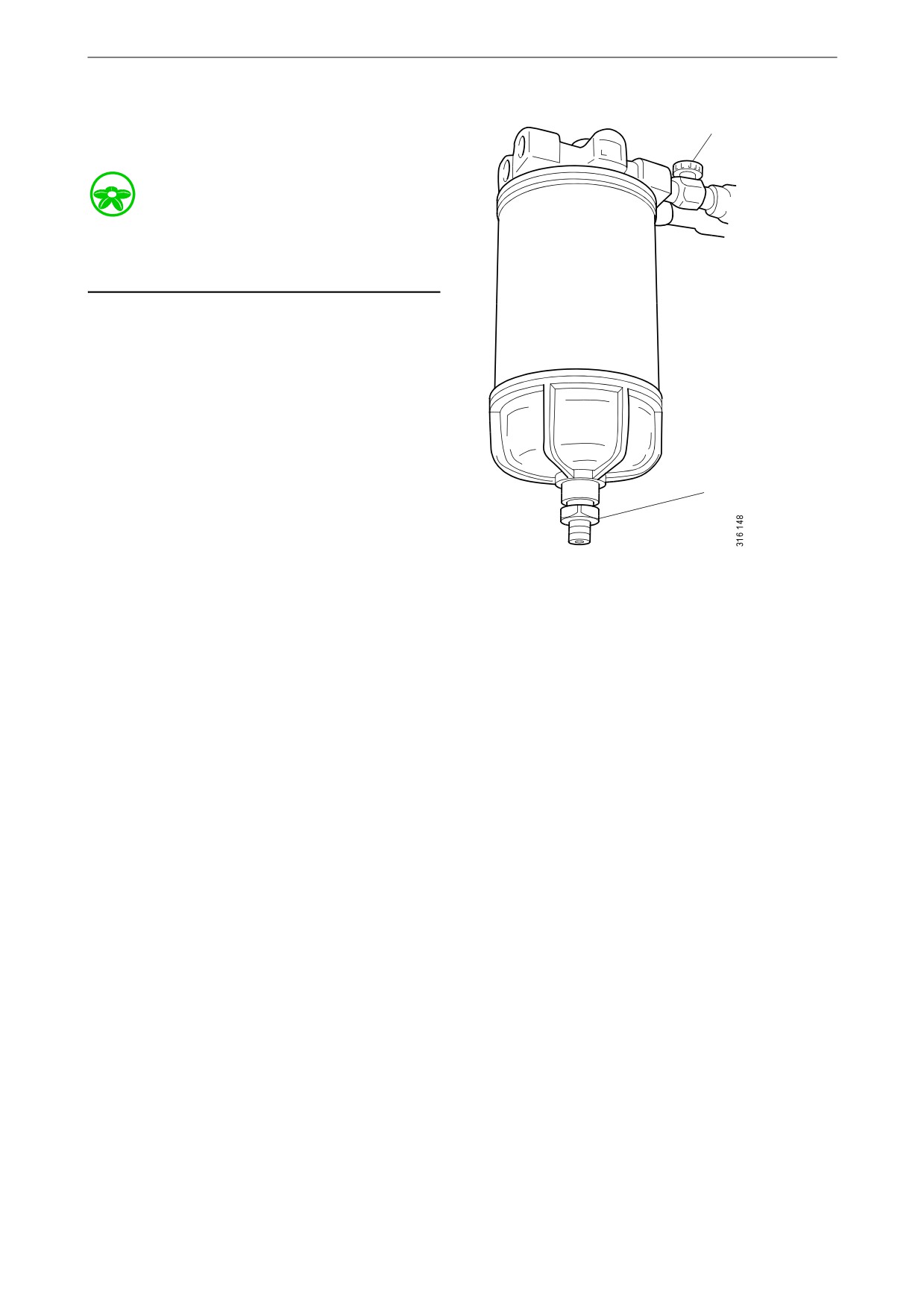
Fuel system
Renewing the water separat-
1
ing prefilter
Environment
Use a suitable container. The fuel collected must
be disposed of as specified in national and inter-
national laws and regulations.
Before starting work: Close the shut-off cock in
the fuel pipe, if there is one, and position a con-
tainer under the filter.
1. Open the drain tap on the filter cover and let
the fluid run down into the container.
2. Unscrew the filter cover.
3. Unscrew the filter from the filter head.
2
4. Discard the old filter and use a new filter.
5. Lubricate the O-ring in the filter cover with
engine oil.
6. Screw the filter cover onto the new filter by
1. Shut-off cock
hand. Make sure that the drain tap is fully
2. Drain tap
closed.
7. Lubricate the O-ring on the filter with engine
oil.
8. Fill the width of the filter with clean fuel.
9. Screw the filter into position until the O-ring
rests against the filter head. Tighten the filter
another 1/2 to 3/4 turn by hand.
10. Open the shut-off cock and check the system
for leaks.
11. Bleed the fuel system as per the following
section.
55

Fuel system
Renewing the fuel filter
Tools
Designation
Illustration
Hexagon socket, 1/2",
36 mm
Environment
Use a suitable container. The fuel collected must
be disposed of as specified in national and inter-
national laws and regulations.
Before starting work: Close the shut-off cock in
the fuel pipe, if there is one, and position a con-
tainer under the filter.
25 Nm
1. Open the bleed nipple on the fuel filter hous-
ing to release any remaining pressure. It may
be difficult to unscrew the filter cover if the
system pressure has not fallen enough.
2. Unscrew the filter cover with the socket.
IMPORTANT!
Do not use an adjustable spanner or other open
tool, as there is a risk of damaging the filter cov-
er.
3. Lift the filter cover with filter element out of
the fuel filter housing. The fuel filter housing
will drain automatically (slowly) once the
filter element has been removed.
IMPORTANT!
If draining is not working, the remaining fuel
should be removed.
56
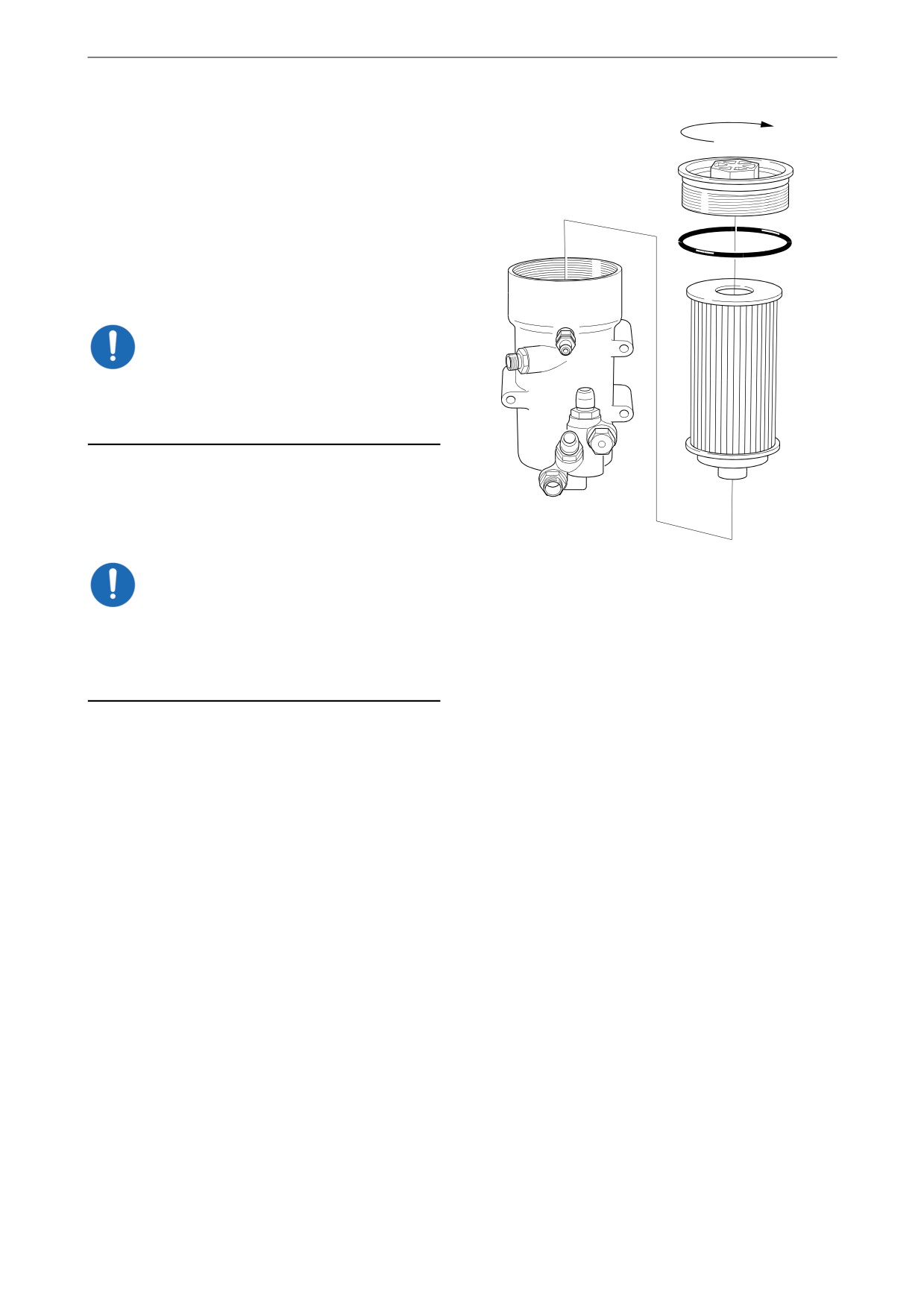
Fuel system
4. Unscrew the overflow valve and blow the
25 Nm
strainer in the filter housing clean. Also wipe
the bottom of the filter housing.
5. Undo the old filter element from the cover by
carefully bending it to one side.
6. Fit a new O-ring on the cover. Lubricate the
O-ring with O-ring grease.
7. Press a new filter element into the snap fas-
tener in the cover.
IMPORTANT!
Fit the filter element into the cover before plac-
ing it in the fuel filter housing or the filter ele-
ment might be damaged.
8. Press down the filter element into the hous-
ing with the cover. Screw on the filter cover
firmly with the socket. Tightening torque
25 Nm (18 lb-ft).
IMPORTANT!
Screw on the cover to the specified torque or the
filter element may break. Do not use an adjusta-
ble spanner or other open tool, as there is a risk
of damaging the filter cover.
9. Bleed the fuel system as per the following
section.
10. Start the engine and check that no leakage
occurs.
57
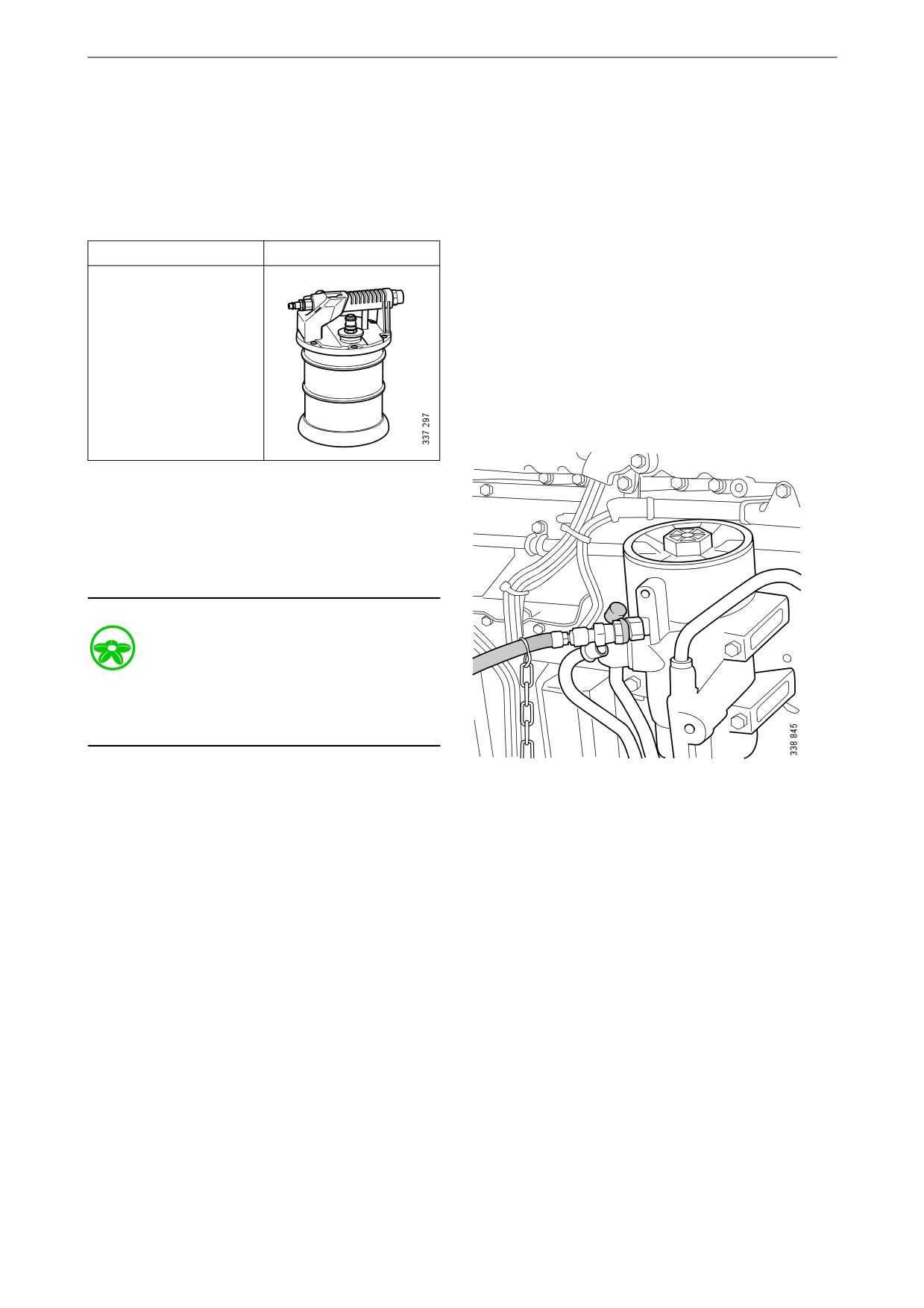
Fuel system
Bleeding the fuel system
Bleeding the fuel system using a suc-
tion tool
Tools
Designation
Illustration
Suction tool
Note:
Scania recommends bleeding the fuel system us-
ing suction tools rather than with a hand pump.
This is a quicker and simpler method, which en-
sures a complete bleeding.
Environment
Use a suitable container. The fuel collected must
be disposed of as specified in national and inter-
national laws and regulations.
1. Attach a clear plastic hose to the bleed nipple
on the fuel filter housing. Place the end of the
plastic hose in a container that holds at least
3 litres (1 US gallon).
58

Fuel system
2. Connect the suction tool.
3. Connect compressed air to the suction tool.
Turn the rotary control to create a vacuum.
4. Open the bleed nipple. Hold the suction tool
straight and draw out at least a full container
of fuel.
Once the fuel coming out of the hose is free
of air bubbles, then bleeding is complete.
5. Close the bleed nipple. Remove the hose and
suction tool.
6. Start the engine and check that no leakage
occurs.
59
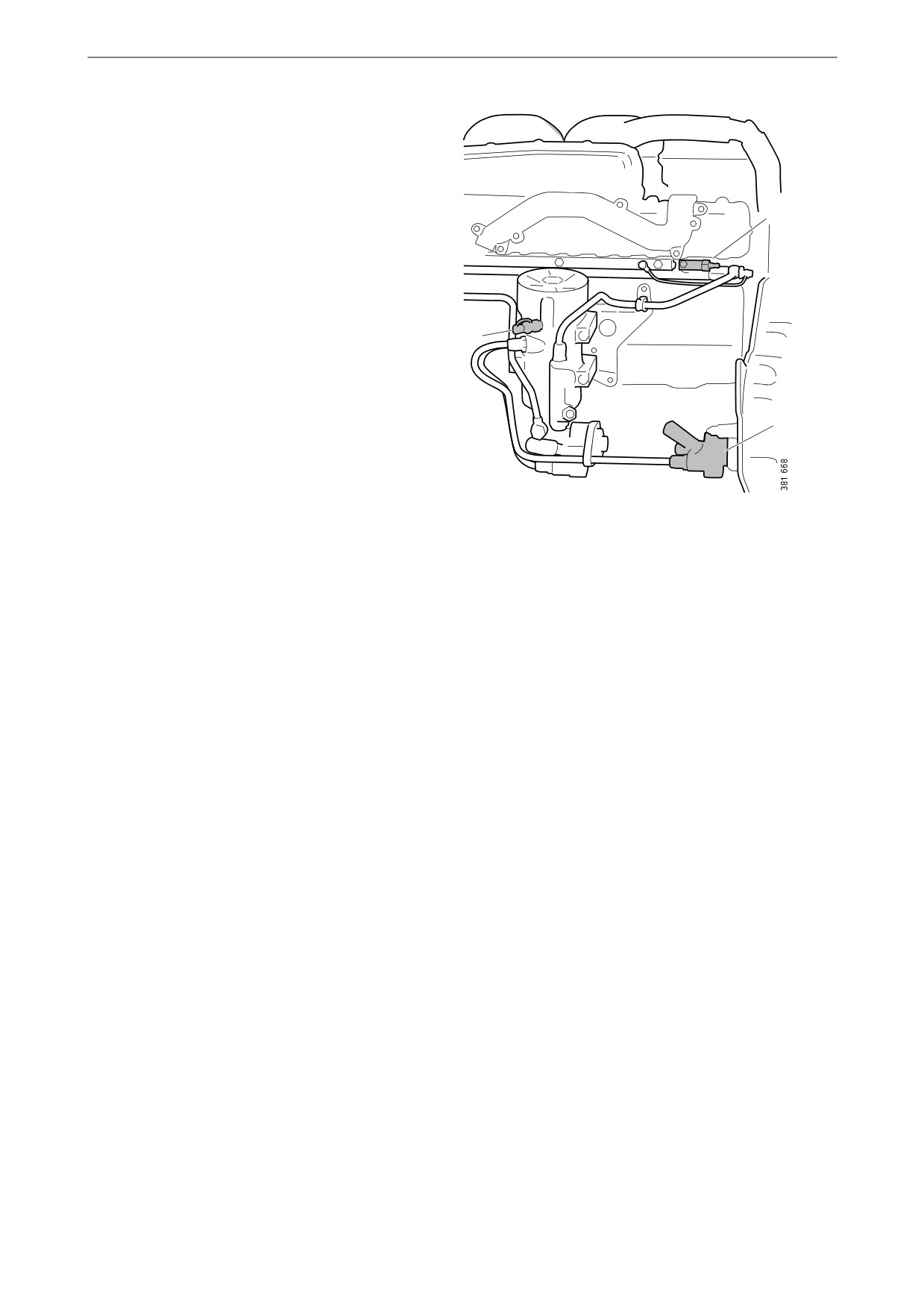
Fuel system
Bleeding the fuel system using a
hand pump
1. Attach a clear plastic hose to the bleed nipple
on the fuel filter housing (1). Place the end of
the plastic hose in a container that holds at
2
least three litres (1 US gallon).
2. Open the bleed nipple and pump with the
hand pump (3) until fuel comes out of the
hose. If the fuel system is empty, it is neces-
sary to pump approximately 100 strokes in
order to draw up the fuel. Depending on the
1
installation, a significantly greater number of
pump strokes may be required before fuel
comes out.
3. Pump until fuel without air bubbles comes
out, approximately 20 strokes.
3
4. Close the bleed nipple and remove the hose.
5. Transfer the hose to the fuel manifold bleed
nipple (2).
1. Fuel filter housing bleed nipple.
6. Open the bleed nipple and pump using the
hand pump (3) until fuel without air bubbles
2. Fuel manifold bleed nipple.3. Hand pump.
appears, approximately 50 pump strokes.
7. Close the bleed nipple and remove the hose.
8. Pump approximately 20 strokes with the
hand pump until the overflow valve opens. A
hissing sound should be heard.
9. Start the engine. The engine should be easy
to start.
10. If the fuel filter has been renewed, check that
no fuel is leaking from the filter. If there is
leakage, tighten the filter more.
60
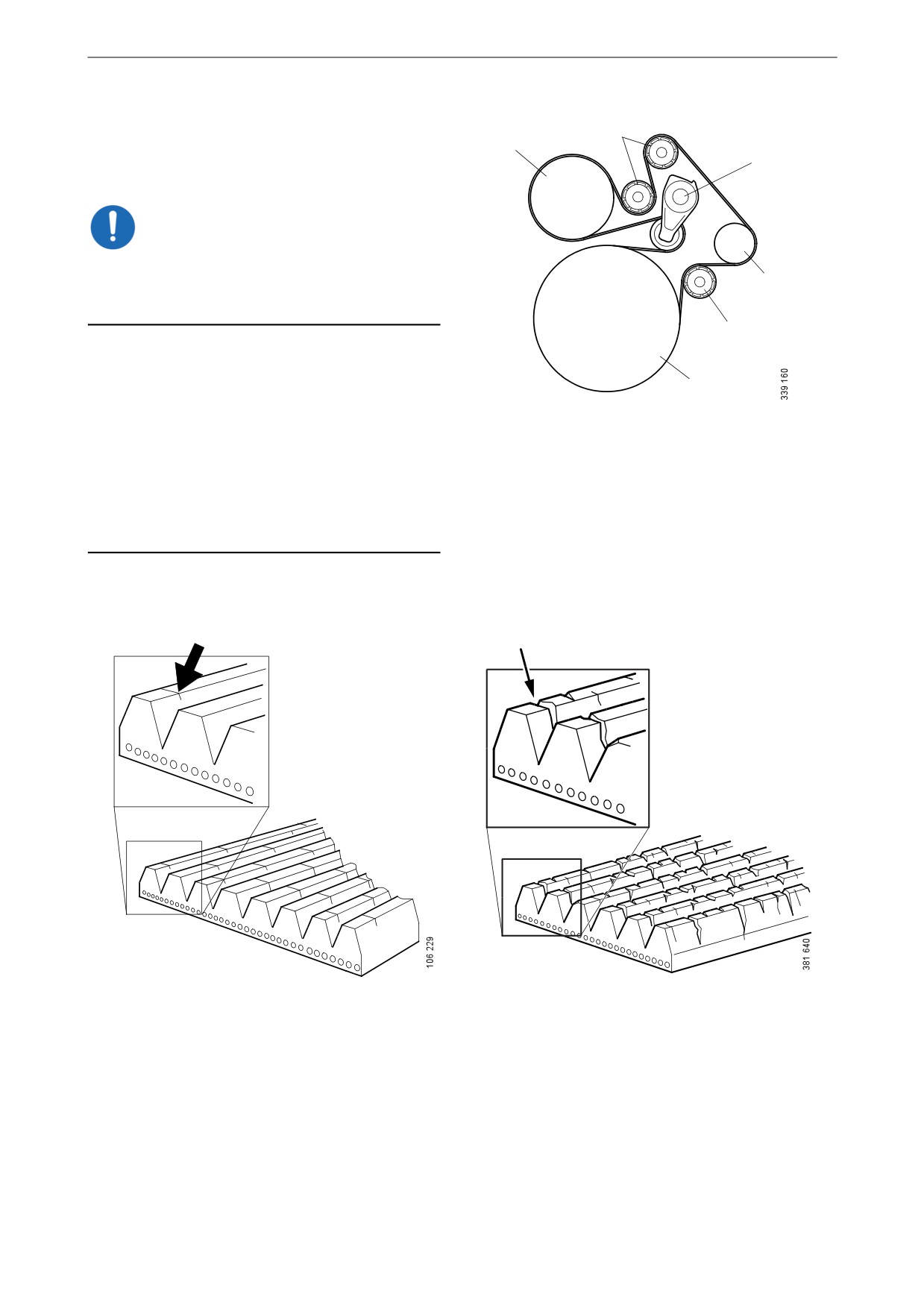
Other
Other
2
5
4
Checking the drive belt
IMPORTANT!
Before starting, make a note of how the drive belt
is fitted. Refit the drive belt with the same direc-
3
tion of rotation as it had before removal.
2
1. Check the drive belt for cracks. Renew the
drive belt if deep cracks have formed.
1
Note:
Example of a drive belt.
Small and shallow cracks are normal and form
1. Crankshaft
after only a few hours of operation. They do not
mean that the drive belt needs to be renewed. If
2. Idler roller
there are many deep cracks, or if parts of the
3. Alternator
drive belt have started to come off, the drive belt
must then be renewed.
4. Belt tensioner
5. Coolant pump
Example of a minor crack in the drive belt. The drive The drive belt has deep cracks and must be renewed.
belt can be refitted.
61

Other
2. Check drive belt wear. Renew the drive belt
if it is too worn.
The drive belt is starting to become worn, but can be
The belt is worn down to the cord. The drive belt
refitted.
must be renewed.
Checking for leaks
IMPORTANT!
If serious leakage occurs, contact your nearest
Scania workshop.
1. Start the engine.
2. Check for oil, coolant, fuel, air or exhaust
leaks.
3. Tighten or renew leaking connections.
Check the overflow holes which show
whether the O-rings between the cylinder
liners and crankcase are leaking.
4. Check whether the drain hole on the coolant
pump is blocked. If there is a leak, renew the
pump seal or the entire coolant pump.
62
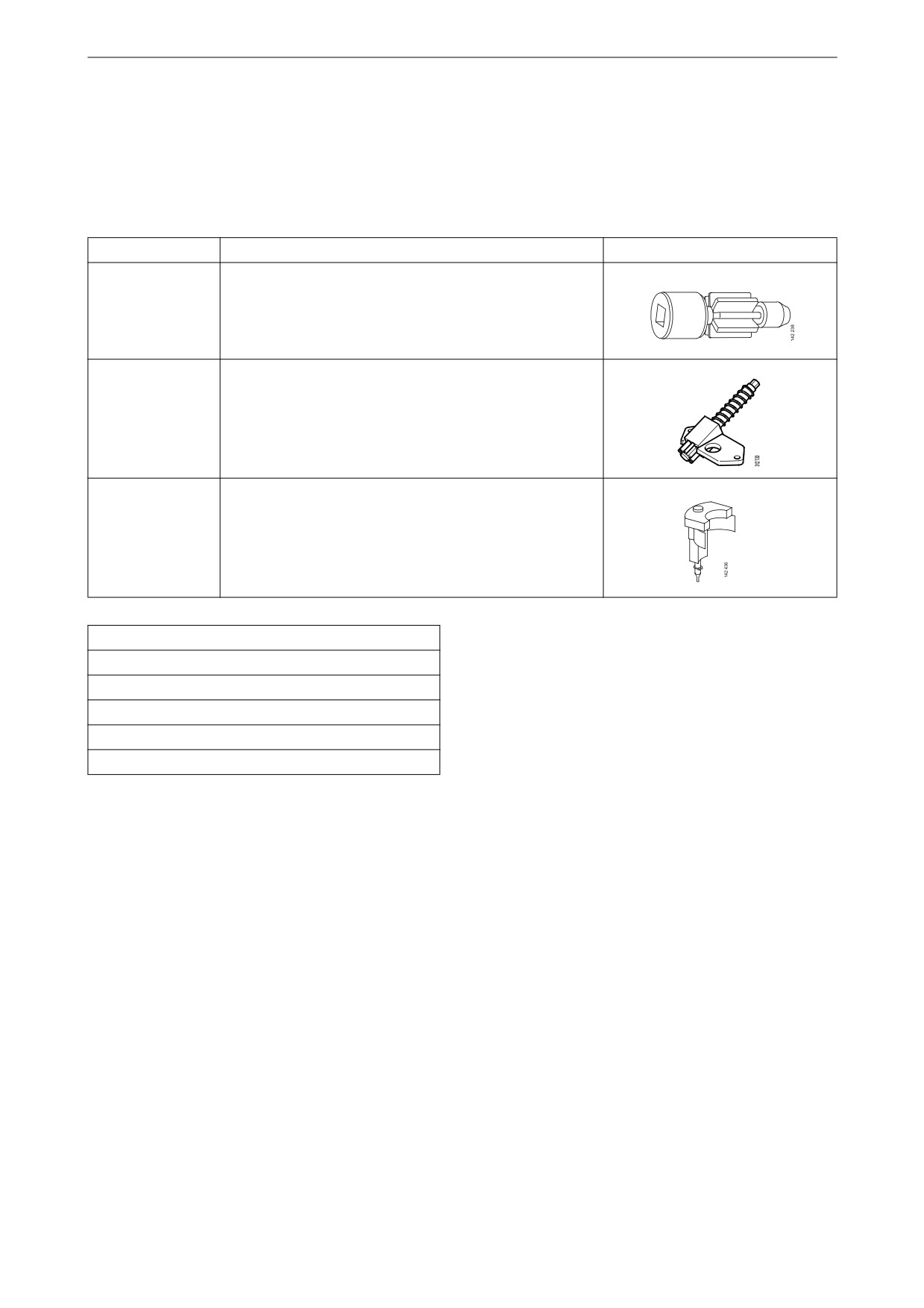
Other
Checking and adjusting the
valve clearance and unit in-
jectors
Special tool
Number
Designation
Illustration
99 309
Turning tool for rotating the flywheel from below
2 402 509
Turning tool for rotating the flywheel from above
99 442
Setting tool
Other tools
Torque wrench, 0-50 Nm
Waterproof felt-tip pen
0.45 and 0.70 mm feeler gauges
Flash light
Mirror
63